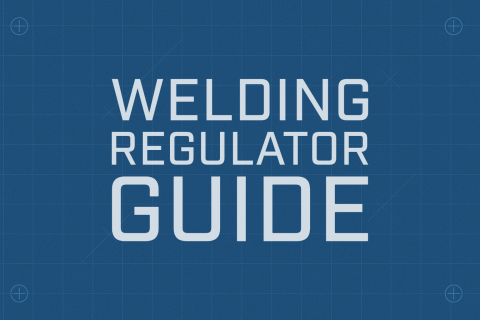Gas regulators may not look like the most exciting part of your kit, but they’re one of the most critical. They reduce the high pressure inside a gas cylinder to a safe, stable level and deliver the right flow for your process. Without the correct regulator, you risk poor welds, wasted gas, or serious safety hazards.
This guide explains how regulators work, the main types welders use, how to choose the right one for MIG, TIG, and oxy-fuel applications, and the best practices for safe installation and maintenance.
👉 We stock a wide range of Gas Arc and premium regulators designed for oxy-fuel, MIG, and TIG welding.
🔎 Gas Regulators at a Glance
| Regulator Type | Pressure Range | Welding Process | Best For |
|---|---|---|---|
| Single-Stage | High → Working (1 step) | Oxy-fuel cutting, brazing | General shop use |
| Dual-Stage | High → Medium → Working (2 steps) | MIG, TIG | Precise, stable shielding gas |
| High-Pressure | Up to 300 bar | Oxy-fuel heating, gouging | Heavy-duty, high flow |
| Low-Pressure | < 20 bar | MIG/TIG shielding gases | Fine control |
| Specialty | Varies | Exotic/reactive gases | Lab work, specialist welding |
⚙️ How Gas Regulators Work
A regulator’s job is to take high-pressure gas from the cylinder and reduce it to a safe, controlled flow:
- High-pressure gas enters via the inlet port.
- It passes through a filter and valve assembly.
- A spring and diaphragm balance against outlet pressure to regulate flow.
- As pressure drops during welding, the diaphragm flexes and the valve opens — keeping output steady.
⚠️ Important: Regulators can be affected by temperature, impurities, or incorrect gas type. Always match the regulator to the gas, and check it for leaks or damage before use.
🛠️ Selecting the Right Regulator
When choosing a regulator, consider:
- Gas Type → Oxygen, acetylene, argon, CO₂, or mixes. Regulators are gas-specific with different threads (BS, CGA, DIN).
- Application → Oxy-fuel cutting/brazing vs. MIG/TIG shielding. TIG benefits from dual-stage stability.
- Flow Rate → Measured in L/min or CFH. Higher flow = larger regulator.
- Equipment Compatibility → Match hoses, fittings, and torches. Some setups need adapters.
- Safety Certification → CE, ISO, or AWS/BS standards.
⚠️ Tip: Never use an oxygen regulator on fuel gas (or vice versa). Threads and seals are different for safety.
🔒 Best Practices for Installation & Maintenance
Installation
- Crack the cylinder valve briefly to clear dust before attaching.
- Hand-tighten, then snug with the correct spanner (no overtightening).
- Open cylinder valves slowly to avoid regulator “slam.”
Maintenance
- Check regularly for leaks with soapy water.
- Keep threads clean, never use oil or grease (especially on oxygen regulators).
- Replace diaphragms, filters, and gauges as per manufacturer guidance.
- Store regulators upright, dry, and away from impact.
Troubleshooting Quick Reference
| Symptom | Likely Cause | Fix |
|---|---|---|
| Creeping pressure | Worn seat/diaphragm | Replace regulator |
| Inconsistent flow | Blocked filter or wrong regulator type | Clean or swap regulator |
| Hissing/leaks | Faulty seals or loose fittings | Replace seals, tighten fittings |
📊 Common Gases & Regulators
| Gas | Cylinder Pressure | Typical Regulator Type | Notes |
|---|---|---|---|
| Oxygen | Up to 200 bar | Single/Dual-Stage, High-Pressure | Never contaminate with oil/grease |
| Acetylene | < 15 bar | Low-Pressure Fuel Gas | Must always use flame arrestors |
| Argon/CO₂ | 150–200 bar | Dual-Stage, Low-Pressure | Standard MIG/TIG shielding gases |
| Argon/Helium Mix | 150–200 bar | Dual-Stage | Ideal for aluminium TIG |
| Propane | ~7 bar | Low-Pressure Fuel Regulator | Heating & cutting only |
✅ Final Thoughts
Gas regulators may not be flashy, but they’re essential for safety, weld quality, and cost efficiency. Selecting the correct regulator, installing it properly, and maintaining it regularly will:
- Ensure a stable arc and consistent weld quality
- Prevent dangerous leaks or regulator failure
- Save gas, money, and downtime
👉 Whether you’re running MIG, TIG, or oxy-fuel, the right regulator makes all the difference.




